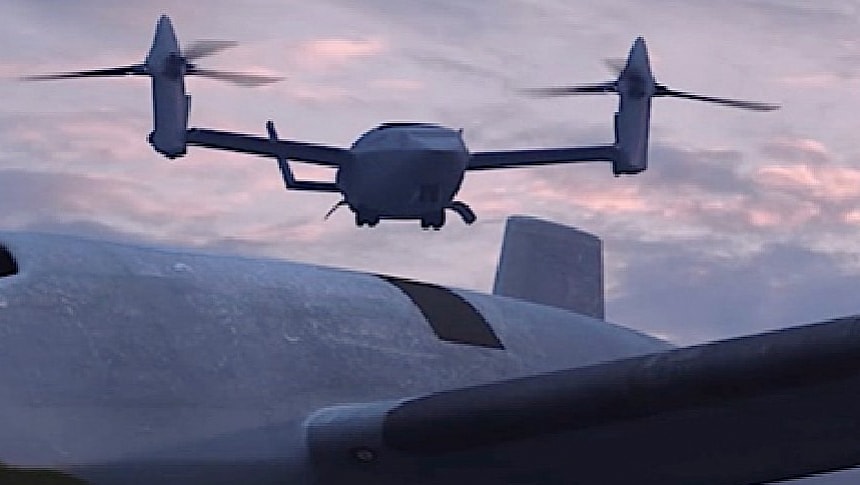There will come a time in the near future when aircraft will seem like nothing we presently have at our disposal. From stranger and stranger shapes to increasingly insane capabilities, aircraft of the future are set to change aviation forever. And Defense Advanced Research Projects Agency (DARPA) is, in many cases, at the center of it all.
The research agency has a number of ongoing programs aimed at transforming aircraft capabilities. One of them is called the SPeed and Runway INdependent Technologies (SPRINT) program, and it started at the end of last year.
SPRINT has a single purpose in mind: to develop new technologies and novel ways to scale and integrate them in the military aircraft of the future. More to the point, DARPA is looking for tech that can give vertical take-off and landing (VTOL) vehicles that require no runway to operate the speed of a jet aircraft.
That's 518 mph (833 kph), reached and maintained at relevant (but undisclosed) altitudes. The aircraft will have to be able to take off and land like a helicopter, but when in flight it will have to behave more or less like a jet.
To get to these new technologies, DARPA tasked in 2023 four companies with coming up with a design proposal for an experimental aircraft: Aurora Flight Sciences, Bell Textron, Northrop Grumman, and Piasecki Aircraft Corporation.
Earlier in May, Aurora Flight Sciences, a subsidiary of Boeing, presented its take on the matter. We saw, in rendering form, an aircraft-shaped vertical lift contraption that relies on a fan-in-wing design.
This week is the turn of Bell Textron to present its concept, after the company was selected to move, alongside Aurora, into the next stage of the SPRINT program. The helicopter specialist does not provide too many details on what we're to expect, but the images and details it released paint the picture of a tiltrotor machine the likes of the V-280 Valor the company is developing for as part of the U.S. Army Future Long-Range Assault Aircraft (FLRAA) program.
The Bell design will use tech developed as part of the so-called high-speed vertical takeoff and landing (HSVTOL) projects it's been working on for a while. At the core of the HSVTOL's supposedly revolutionary capabilities sits a folding rotor design "that efficiently converts horsepower into vertical lift thrust." What folding rotor means is that the blades sweep back and stop spinning, allowing the VTOL to behave like a jet aircraft.
As per Bell, the rotor has been designed in such a way as to generate as little downwash as possible (up to 90 mph / 145 kph). It's also meant to bring down the aircraft's signature to a minimum level in a bid to increase its survivability.
The company already performed a series of tests on the folding rotor, integrated propulsion, and flight control technologies at the Holloman Air Force Base. This happened at the end of last year, but no other details were provided.
The DARPA SPRINT program does not come with a public timetable, meaning there's no way of telling when we'll be able to see the first products resulting from it come to light.
SPRINT has a single purpose in mind: to develop new technologies and novel ways to scale and integrate them in the military aircraft of the future. More to the point, DARPA is looking for tech that can give vertical take-off and landing (VTOL) vehicles that require no runway to operate the speed of a jet aircraft.
That's 518 mph (833 kph), reached and maintained at relevant (but undisclosed) altitudes. The aircraft will have to be able to take off and land like a helicopter, but when in flight it will have to behave more or less like a jet.
To get to these new technologies, DARPA tasked in 2023 four companies with coming up with a design proposal for an experimental aircraft: Aurora Flight Sciences, Bell Textron, Northrop Grumman, and Piasecki Aircraft Corporation.
Earlier in May, Aurora Flight Sciences, a subsidiary of Boeing, presented its take on the matter. We saw, in rendering form, an aircraft-shaped vertical lift contraption that relies on a fan-in-wing design.
This week is the turn of Bell Textron to present its concept, after the company was selected to move, alongside Aurora, into the next stage of the SPRINT program. The helicopter specialist does not provide too many details on what we're to expect, but the images and details it released paint the picture of a tiltrotor machine the likes of the V-280 Valor the company is developing for as part of the U.S. Army Future Long-Range Assault Aircraft (FLRAA) program.
The Bell design will use tech developed as part of the so-called high-speed vertical takeoff and landing (HSVTOL) projects it's been working on for a while. At the core of the HSVTOL's supposedly revolutionary capabilities sits a folding rotor design "that efficiently converts horsepower into vertical lift thrust." What folding rotor means is that the blades sweep back and stop spinning, allowing the VTOL to behave like a jet aircraft.
As per Bell, the rotor has been designed in such a way as to generate as little downwash as possible (up to 90 mph / 145 kph). It's also meant to bring down the aircraft's signature to a minimum level in a bid to increase its survivability.
The company already performed a series of tests on the folding rotor, integrated propulsion, and flight control technologies at the Holloman Air Force Base. This happened at the end of last year, but no other details were provided.
The DARPA SPRINT program does not come with a public timetable, meaning there's no way of telling when we'll be able to see the first products resulting from it come to light.






